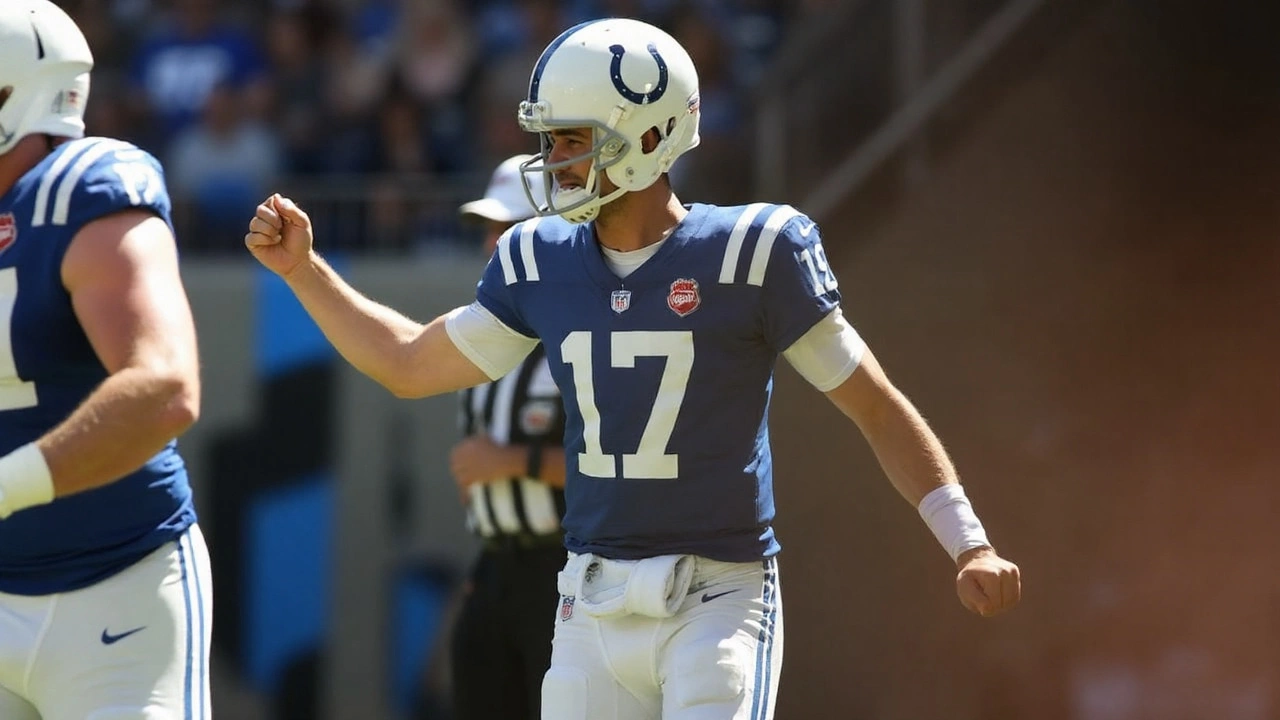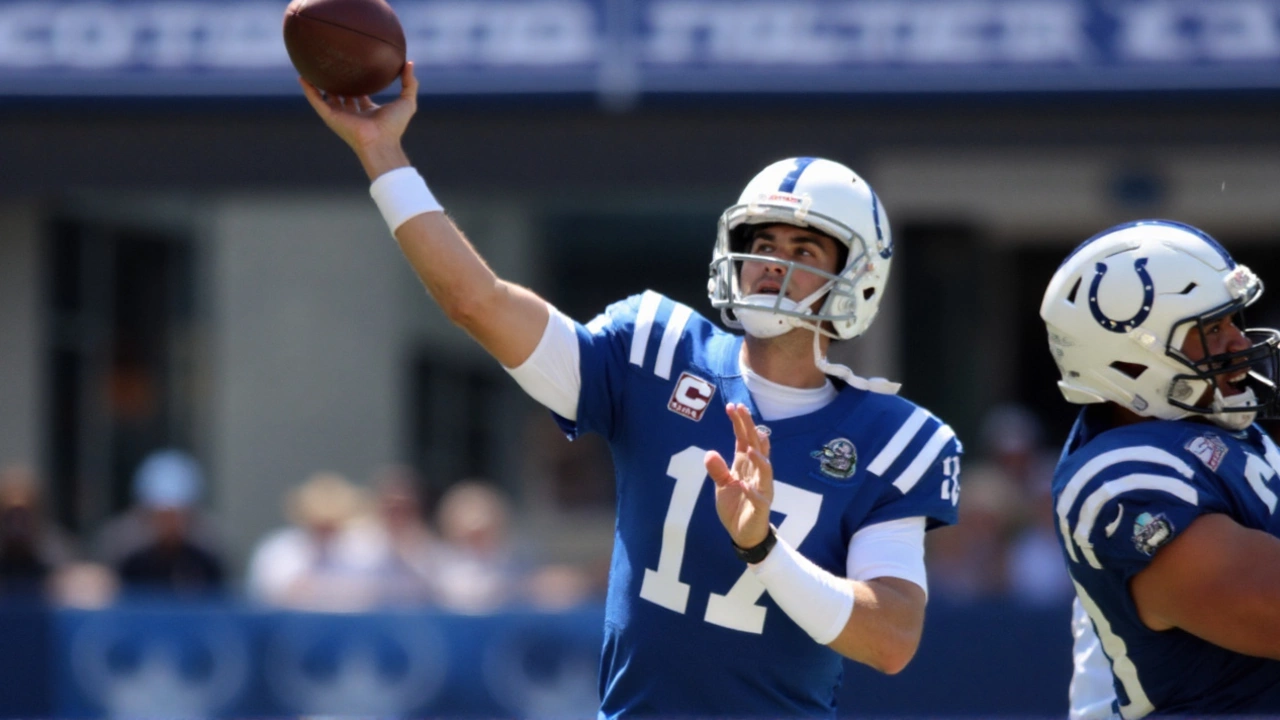A steady hand ends an ugly streak
The first thing to know about Week 1 in Indianapolis: the drought finally broke. The Colts hadn’t won an opener since 2013. Eleven straight trips to Week 1 ended the same way—flat starts, frayed nerves, heads down by sundown. On Sunday, that changed. The scoreboard read 33-8 against Miami, and the new quarterback stood in the middle of it all, calm and tidy where chaos used to live.
Daniel Jones didn’t just manage the game; he owned the pacing of it. He completed 22 of 29 passes (76%) for 272 yards and a touchdown, mixed in two one-yard rushing scores, and took just one sack. No turnovers. No panic throws. No wasted possessions. The Colts scored on all seven of their drives, which is rare in today’s NFL and even rarer for a quarterback making a debut in a new uniform.
The context matters. Three weeks ago, the Colts named Jones the starter over Anthony Richardson, the high-ceiling passer they’d invested a lot of hope in. That decision was as much about risk as it was about talent. Richardson can tilt the field. He can also tilt it the other way if things go sideways early. Jones, the veteran, offered something simpler: a clean platform for the entire operation to function. On Sunday, that’s what showed up.
Jones set the tone in the first half with 197 passing yards—his best single-half total as a pro. He pushed the ball when Miami sat soft, hit the quick stuff when they pressed, and leaned into the run when the Dolphins’ fronts spread out. The 27-yard touchdown to Michael Pittman Jr. landed exactly where it had to—far enough to beat the corner, firm enough to outrun the safety’s angle. That throw felt like more than points. It looked like trust.
It’s hard to overstate the relief in the building. This was Jones’ first win as a starting quarterback since October 6 of his final year with the Giants, the season that eventually led to his release. He said the right things afterward—“good start,” “play as a team,” “keep improving”—and, yes, it sounded like a veteran who understands Week 1 is a chapter, not the book. But you could see it on teammates’ faces too. They’ve started too many seasons wobbling. This time, they walked out steady.
What changes with one efficient afternoon? Not everything. The Dolphins looked oddly flat. Their pass rush never really landed, and their coverage lost leverage in the red zone. But that doesn’t undercut what Indianapolis did. The Colts didn’t just beat a good roster. They left almost no openings for momentum to flip. That’s the sign of a plan that connected with the locker room and, just as important, a quarterback who put the ball in safe places.
Here’s why it worked:
- Early-down rhythm throws kept the offense ahead of schedule. Jones’ timing on quick outs, crossers, and hitches prevented the drive-killing third-and-long traps that have haunted this team.
- Red-zone decisiveness settled nerves. The one-yard keepers weren’t flashy, but they were decisive calls, and Jones executed without hesitation.
- Pre-snap control mattered. Jones set protections, sorted blitz looks, and checked into plays that fit the front. When a quarterback processes cleanly, everyone else plays faster.
- Ball security flipped the field math. Zero giveaways paired with near-perfect efficiency on seven possessions is a nightmare for any opponent trying to steal extra drives.
One thing that jumped out from the sideline: the Colts didn’t chase explosives; they accepted them when Miami offered them. That touchdown to Pittman was a case study—Indy set it up with tempo and underneath completions, then picked a spot when the safety’s depth wavered. When you’re trying to build a new identity, you want a quarterback who takes the obvious profit and knows when to push. Jones did both.
The run game supported the plan without hogging it. The quarterback sneaks at the goal line were the visible pieces, but the real benefit came on the snaps before that: inside zone to keep the linebackers honest, a couple of pin-and-pull looks to stretch the edges, and checkdowns that felt like extended handoffs. Those snaps may not make the highlight rolls, but they control the flow of a game—and they gave Jones second-and-manageable over and over.

How the Colts built a clean, efficient plan
Beating out Richardson changed the temperature of this offense. The Colts didn’t ask Jones to be a superhero. They asked him to be predictable in the best way: on time, on target, on script when the look matched, and off script only when needed. His single sack came late, on a snap where Miami finally guessed right. One play. No avalanche.
What does that tell us about the design? A few layers stand out. First, the passing game leaned on spacing and quick timing. That helps a quarterback get into rhythm and lets receivers win on releases instead of hero ball. Second, the staff leaned into Jones’ legs only where it really hurts a defense—short-yardage and red zone. That’s targeted aggression, not a diet of quarterback runs that invites hits. Third, the protection plan made sense. Chips on the edge when Miami showed wide-9 looks, extra help in the A-gaps when the Dolphins tightened the front. Simple, effective, respectful of the opponent’s strengths.
Jones’ ball placement backed it all up. The stat line—22-of-29—means less if you’re living on throwaways and screens. This wasn’t that. He layered throws between linebackers, toggled trajectory on crossers, and planted back-shoulders when corners sat on routes. Those little choices make the difference between a first down and a punt. They also keep an offense out of the tense, momentum-swinging snaps where games can turn.
The quiet stars were the linemen and backs. One sack tells you protection held, but the details matter: anchors against power, clean handoffs on twists, and backs who met blitzers square. When the quarterback feels the pocket, the ball comes out with conviction. That was the energy all afternoon.
Of course, this is still a quarterback story. When a veteran arrives in a new locker room after a rough exit elsewhere, the dynamics can get awkward fast. Not here, at least not on Sunday. Jones’ voice at the line was steady. His tempo in and out of the huddle never dragged. You could see receivers trusting that if they hit their spot, the ball would meet them there. That is the beginning of chemistry, not the end of it.
On the other sideline, Miami never found a counterpunch. The Dolphins’ fronts showed movement, but the Colts kept them from dictating terms—no explosive sacks, no havoc plays that flip field position. In the secondary, miscommunications popped up near the goal line, which is how those one-yard plunges become routine instead of desperate. When a defense can’t steal a possession, it needs third-down stops. Indianapolis didn’t gift any.
What changes now for the depth chart? The Colts were clear: Richardson lost a competition, not the franchise’s belief. That matters. A healthy quarterback room is not a reality show. Richardson’s development continues, and the staff gains breathing room to bring him along on schedule, not emotion. If Jones keeps this level of control, the Colts can be selective with change-ups for Richardson—packages that stress defenses without pulling the offense out of rhythm.
The receiver picture bears watching. Pittman looked like a true lead option, but the deeper win came from distribution. Jones spread the ball—forcing Miami to defend every blade of grass. That reduces the burden on any one target, keeps a grooved rhythm, and prevents coverage from squatting on tendencies. When you can beat man with leverage and zone with patience, you don’t need superhuman plays to move the chains.
The red zone is where skeptics usually circle Jones’ name. He answered that early. Two one-yard keepers may feel basic, but they tell a story: the staff trusted the read, and the quarterback executed it without delay. Red-zone offense feeds on conviction. If you hesitate, you kick. If you commit, you score. Indianapolis committed.
Then there’s the psyche of a fan base that has been waiting for a clean opener for more than a decade. The relief is real, but so is the measuring stick ahead. Defenses will adapt. They’ll crowd early windows, force deeper throws outside the numbers, and dare the Colts to keep stacking error-free drives. That’s the next test for Jones: handle the counters without drifting into risky habits that popped up at times in his earlier stops.
Jones’ post-game answer fit the day: composed, a little guarded, not chest-thumping. You can’t fake that with teammates. Win the room on Wednesday, not just Sunday, and veterans buy in. It’s practice tempo, protection calls, film notes, and the first 15 plays scripted for rhythm. That is the grind that turns a clean debut into a trend.
There’s also the broader chessboard. An efficient Week 1 does more than lift spirits. It stabilizes rotations, trims special-teams strain, and helps the defense play from ahead. When you score on every drive, your coverages can stay layered, your fronts can rush with freedom, and your coordinator can call the game without chasing. Complementary football isn’t a buzzword when the offense operates like this. It’s the hidden yardage you feel in the fourth quarter.
None of this guarantees a sequel. The league adjusts quickly. Tape circulates. Tendencies get charted. Next week, Indianapolis will see different pressures, disguised shells, and baited throws that test Jones’ patience. That’s fine. The value of Week 1 is the baseline it sets. The Colts now know what it looks like when they stay on schedule, protect the ball, and finish drives. They have a template.
For one Sunday, the story in Indianapolis was simple: a veteran quarterback played with clarity, the plan matched the moment, and an 11-year weight came off a franchise’s shoulders. If the Colts keep this version of Jones—decisive, efficient, unbothered by noise—September won’t feel like a trapdoor anymore. It will feel like a runway.





